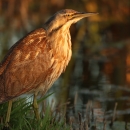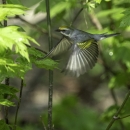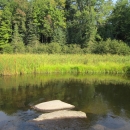Seasons of Wildlife
In the spring, bears emerge from their dens and spring flowers briefly bloom in the northern hardwood forest. Warblers and songbirds return to the refuge, with some migrating through and others redefining their territory for breeding season.
In the summer months, foxes raise their kits, trumpeter swan families cruise around the wetlands that sparkle in the summer sun.
Fall brings the ripening of wild rice and large numbers of migrating ducks. Wild rice is typically ready for harvest by Native Americans in September and peak numbers of ring-necked ducks can be viewed in mid-October.
During the winter months, enjoy the quiet peace and search for tracks that animals leave behind. Otters remain active and foxes continue to trot through the refuge.
Featured Species
The refuge is composed of a variety of wetlands, fens and forest. The northern hardwood forest along the wildlife drive is dominated by quaking and big-toothed aspens, red and sugar maples, paper birch, basswood, and red oak. Breeding birds on the refuge depend on different types and sizes of forest. For example, golden-winged Warblers breed in young forest and along brushy edges, while ovenbirds nest in the forest interior. Most of the world’s golden-winged warblers breed and nest in central Minnesota, and unfortunately, their population is in rapid decline. Rice Lake National Wildlife Refuge biologists are working hard to restore and manage the young forest habitat they breed in and to help stabilize their population. Look and listen for their “bee buzz buzz” song in the forest openings and brushy edges along the wildlife drive.
On the refuge wetlands, look for trumpeter swans. After disappearing from Minnesota in the 1880s, trumpeter swans were reintroduced to the state beginning in the 1960s. To prevent their extinction, several conservation agencies made an effort to raise and release trumpeter swans within the state. The refuge is now the host of numerous nesting pairs of trumpeter swans and has participated in efforts to track swan movement. Several swans in multiple states have been fitted with collar transmitters in a collaborative project to learn more about these birds' movements. You can learn more about their whereabouts when you stop at the refuge headquarters.
In the fall, ring-necked ducks steal the show at the refuge during their southerly migration. In October 1994, more than one million ducks were observed - a Minnesota record - most of which were ring-necked ducks. They breed and nest along the forested wetlands of the boreal region in Canada. During fall migration, huge flocks stop to feed and rest in the wild rice beds of Rice Lake. Mid-October is the best time to view large numbers of migrating ring-necked ducks at the refuge. The 2019 fall waterfowl survey saw an astounding peak count of 896,000 waterfowl with 883,000 being ring-necked ducks. Fall duck populations are directly tied to the wild rice produced on Rice Lake. In years with great rice crop, the refuge sees the greatest numbers of waterfowl. Poor rice crop yields fewer ducks.







